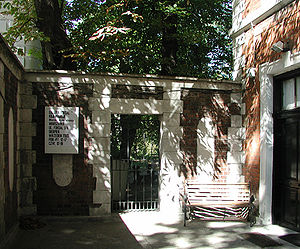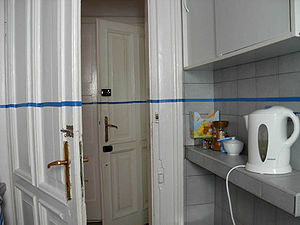
Foksal Gallery
Encyclopedia



Warsaw
Warsaw is the capital and largest city of Poland. It is located on the Vistula River, roughly from the Baltic Sea and from the Carpathian Mountains. Its population in 2010 was estimated at 1,716,855 residents with a greater metropolitan area of 2,631,902 residents, making Warsaw the 10th most...
, Poland
Poland
Poland , officially the Republic of Poland , is a country in Central Europe bordered by Germany to the west; the Czech Republic and Slovakia to the south; Ukraine, Belarus and Lithuania to the east; and the Baltic Sea and Kaliningrad Oblast, a Russian exclave, to the north...
established in 1966. Its small size belies its internationally influential reputation as a gallery that maintains a strong tradition of showing work by avant-garde
Avant-garde
Avant-garde means "advance guard" or "vanguard". The adjective form is used in English to refer to people or works that are experimental or innovative, particularly with respect to art, culture, and politics....
contemporary artists.
History
The Foksal Gallery was founded in 1966 by a group of Polish art critics and artists, which included one of the founder members of the Polish ConstructivistConstructivism (art)
Constructivism was an artistic and architectural philosophy that originated in Russia beginning in 1919, which was a rejection of the idea of autonomous art. The movement was in favour of art as a practice for social purposes. Constructivism had a great effect on modern art movements of the 20th...
Group of the 1920s. From the outset the gallery's activities were underpinned by the strong philosophical basis embodied within the essay "Wprowadzenie do ogolnej Teorii Miejsca (Introduction to the general Theory of Place)" (1966). The critics associated with the Foksal Gallery; Anka Ptaszkowska, Mariusz Tchorek, Wiesław Borowski established the gallery as a "place, a sudden gap in the utilitarian way of world comprehension", in which art could exist without reference to context or history, a place exempt from outside rules or influence. They also proposed that the venue, ‘as the most authentic theme of the event’, was now to become the actual subject. In addition to the aforementioned critics, the artist-founders at the Foksal included Tadeusz Kantor
Tadeusz Kantor
Tadeusz Kantor was a Polish painter, assemblage artist, set designer and theatre director. Kantor is renowned for his revolutionary theatrical performances in Poland and abroad.- Life and career :...
,
Roman Owidzkiego, Edward Krasinski (whose signature blue Scotch tape intervention still winds its way through the gallery's ancillary spaces), Zbigniew Gostomski and Henryk Stażewski
Henryk Stazewski
Henryk Stażewski was a Polish painter, considered to be a pioneer of the classical avant-garde of the 1920s and 1930s. He was a foremost representative of the Constructivist movement, as well as the co-creator of the Geometric Abstract art movement....
.
Zbigniew Gostomski (b. 1932), a founder artist of the Foksal Gallery, held the inaugural exhibition on 1 April 1966 showing works of his Optical Objects series. Tadeusz Kantor
Tadeusz Kantor
Tadeusz Kantor was a Polish painter, assemblage artist, set designer and theatre director. Kantor is renowned for his revolutionary theatrical performances in Poland and abroad.- Life and career :...
and Wlodzimierz Borowski were involved in actions at the gallery during the 60's. The Foksal succeeded in showing work of an avant-garde nature throughout the communist era, apart from a short period of martial law, during which it was 'closed for renovation'. For its first twenty years the Foksal Gallery functioned within the state controlled system, nonetheless succeeding in developing an internationally significant programme of contemporary art under the Directorship of Wieslaw Borowski in co-operation with Andrzej Turowski. Milada Ślizińska also curated a series of exhibitions. Jaromir Jedlinski (previously of the Museum Sztuki in Łódź), was the gallery's Director from July 2006 until August 2008. Nowadays the gallery is run by the younger generation of curators: Katarzyna Krysiak (Artistic Director/Head Curator), Lech Stangret and Monika Weychert Waluszko.
The gallery acted under the auspices of the Laboratory of Arts Plastycznych (PSP) until 1982, then under SBWA until 2001. At present, it remains government funded under the Mazovia Region Centre For Culture and Art (MCKiS).
The Foksal Gallery has for many years been one of the most influential art galleries in Poland, with shows by many internationally acclaimed artists including Christian Boltanski
Christian Boltanski
Christian Boltanski is French sculptor, photographer, painter and film maker.-Life and work:Having no formal art education, he began painting in 1958. Nevertheless, he first came to public attention in 1960 with few short films and publication of several notebooks...
, Henryk Stażewski
Henryk Stazewski
Henryk Stażewski was a Polish painter, considered to be a pioneer of the classical avant-garde of the 1920s and 1930s. He was a foremost representative of the Constructivist movement, as well as the co-creator of the Geometric Abstract art movement....
, Joseph Beuys
Joseph Beuys
Joseph Beuys was a German performance artist, sculptor, installation artist, graphic artist, art theorist and pedagogue of art.His extensive work is grounded in concepts of humanism, social philosophy and anthroposophy; it culminates in his "extended definition of art" and the idea of social...
, Royden Rabinowitch
Royden Rabinowitch
Royden Rabinowitch, OC is a Canadian sculptor.Rabinowitch was born in Toronto, Ontario, and is the twin brother of sculptor David Rabinowitch...
, Anselm Kiefer
Anselm Kiefer
Anselm Kiefer is a German painter and sculptor. He studied with Joseph Beuys and Peter Dreher during the 1970s. His works incorporate materials such as straw, ash, clay, lead, and shellac...
, Luc Tuymans
Luc Tuymans
Luc Tuymans is a contemporary artist who lives and works in Antwerp, Belgium. Tuymans is considered one of the most influential painters working today. His signature figurative paintings transform mediated film, television, and print sources into examinations of history and memory.-Life:Tuymans...
, Bill Viola
Bill Viola
Bill Viola is a contemporary video artist. He is considered a leading figure in the generation of artists whose artistic expression depends upon electronic, sound, and image technology in New Media...
, Tadeusz Kantor
Tadeusz Kantor
Tadeusz Kantor was a Polish painter, assemblage artist, set designer and theatre director. Kantor is renowned for his revolutionary theatrical performances in Poland and abroad.- Life and career :...
, Ian Hamilton Finlay
Ian Hamilton Finlay
Ian Hamilton Finlay, CBE, was a Scottish poet, writer, artist and gardener.-Biography:Finlay was born in Nassau, Bahamas of Scottish parents. He was educated in Scotland at Dollar Academy. At the age of 13, with the outbreak of World War II, he was evacuated to family in the countryside...
, Koji Kamoji
Koji Kamoji
Koji Kamoji is a Japanese/Polish contemporary artist, who lives and works in Warsaw, Poland.-Life and works:Koji Kamoji is a painter, creator installations and objects....
, Leon Tarasewicz, Douglas Gordon
Douglas Gordon
Douglas Gordon is a Scottish artist; he won the Turner Prize in 1996 and the following year he represented Britain at the Venice Biennale...
, Matthew Barney
Matthew Barney
Matthew Barney is an American artist who works in sculpture, photography, drawing and film. His early works were sculptural installations combined with performance and video...
, Marek Chlanda and Victor Burgin
Victor Burgin
Victor Burgin is an artist and a writer. Burgin first came to attention as a conceptual artist in the late 1960s and at that time was most noted for being a political photographer of the left, who would fuse photographs and words in the same picture. He has worked with photography and film,...
among many other notable names.
In 1997 the Foksal Gallery Foundation was formed to widen the scope of activities of the gallery. Initially based within the Foksal Gallery, the Foksal Gallery Foundation moved out in 2001 and now operates, somewhat controversially (because of the historic "Foksal" brand usage among others), as an independent and commercial entity, that has nothing to do with the Foksal Gallery activities whatsoever. The above often creates a notable confusion between the two institutions both operating in Warsaw completely independently from one another.
Name and Location
The gallery is named after Foksal, the name of the street at the end of which it can be found. 'Foksal' is said to be a Polish corruption of 'Vauxhall' the name given to the street when the Foksal park area was created in the nineteenth century by a merchant who had been inspired by the atmosphere of London's Vauxhall Pleasure GardensVauxhall Gardens
Vauxhall Gardens was a pleasure garden, one of the leading venues for public entertainment in London, England from the mid 17th century to the mid 19th century. Originally known as New Spring Gardens, the site was believed to have opened before the Restoration of 1660 with the first mention being...
in Vauxhall
Vauxhall
-Demography:Many Vauxhall residents live in social housing. There are several gentrified areas, and areas of terraced townhouses on streets such as Fentiman Road and Heyford Avenue have higher property values in the private market, however by far the most common type of housing stock within...
.
Address: Foksal Gallery

